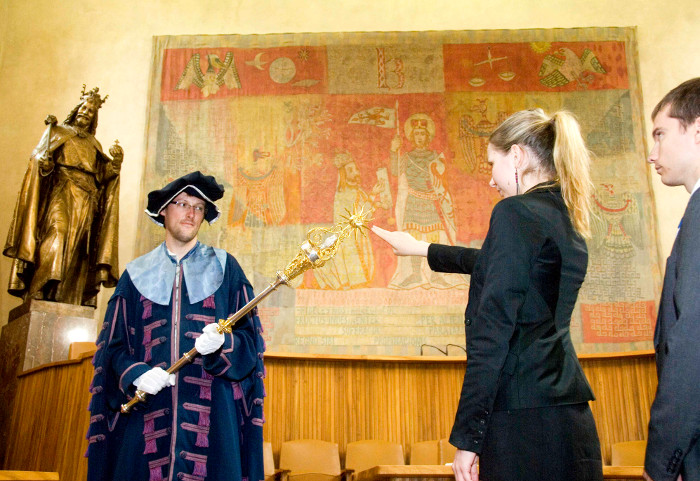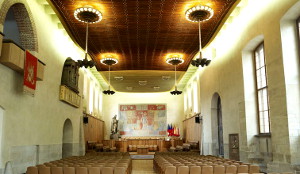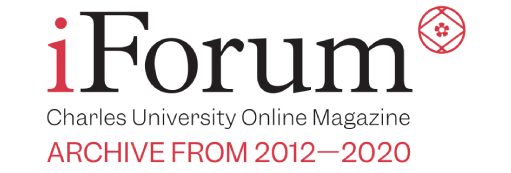Marita Moloney - International iForum • foto: red. • 21 October 2013
Matriculation Ceremony for Faculty of Arts
On what would otherwise have been a rather uninteresting Wednesday on a crisp October afternoon, I had the pleasure of attending a matriculation ceremony for incoming students to the Faculty of Arts at Charles University in Prague. Derived from the Latin word matricula, meaning “a register,” matriculation refers to the formal process of enrolling in a university and to meet the academic standards required by the institution.

Matriculation Ceremony is held in the Magna Aula (Great Hall) of the Carolinum in Prague
The ceremony was held in the Magna Aula (Great Hall) of the Carolinum in Prague, and it certainly lived up to its name as there was no shortage of splendour and grandness in the hall; a perfect setting in which one could soak up the sense of occasion already permeating the room.
The beauty of Gothic architecture is strikingly displayed here, an original feature surviving renovations that occurred in the 1940s and which frames doors and elevated window seats. From an ornate tapestry facing the onlooking students, the eponymous founder of the University, Charles IV, kneels reverently before Prince Wenceslas whilst holding a manuscript comprising of the foundation charter and motto seal. This emblem similarly adorns the university seal. Also creating an eye-catching addition to the front of the room is a collection of 16 flags representing each of the faculties. However, unsurprisingly considering the nature of the hall, there is intriguing history attached to this display, as the Faculty of Arts flag is absent. This is attributed to Jan Palach, a student of history and political economy at Charles University who burned himself in 1968 on Wenceslas Square in political protest, and whose coffin lays forever swathed in the Faculty of Arts flag. Completing the ornate interior is a memorial of a Renaissance man who taught there and a charmingly small adjacent chapel. The hall also hosts traditional transitional rituals such as graduation ceremonies (“promoce”), and the location is undoubtedly befitting of both prestigious occasions, proudly preserved by Charles University.
Adjoining the main hall are two private chambers; one providing ample space for the academics to get ready and another for the students to prepare themselves for the ceremony ahead. The former dress in classic black robes, albeit the most important members wear an assortment of bright colours, while the latter are attired in their own formalwear, which I found unusual compared to the traditional approach taken at such ceremonies at home in Ireland. Interestingly, in the scholars’ room there is a mirror above which the Latin inscription “spondeo ac polliceor” reminds the students of the promise which they are about to make to the university when graduating.

Magna Aula (Great Hall) of the CarolinumThe matriculation ceremony itself from start to finish was ascribed the formality and grandeur you would expect. The students rose from their seats as the academics proceeded into the hall in a well-timed procession accompanied by a melodic rendition of the Czech national anthem, played with aplomb from the high pipes of an organ. Matriculation is not normally open to the public and so it was just the students who listened intently as the speeches ensued. The vice-rector commenced by discussing the history of the university. He impressed the significance of the location on the attendees in explaining that the Carolinum had accumulated 630 years of use by the university, and that Charles University was in fact the oldest university in Europe to the north of the Alps and east of Paris. He also informed them that next year would mark 360 years since the joining of Charles and the Jesuit Ferdinand university, which was indeed an important development at the time. A value which transcends the centuries was also emphasised, that the search for truth and knowledge would always be an intrinsic purpose of the university.
It was the turn of the vice-dean to speak, and he focused on the promise which the students would be making at the ceremony, that being: "I promise to properly exercise the rights and fulfil the duties as a member of the academic community at Charles University. I promise to respect the reputable humanistic and democratic tradition of Charles University, to regard to its good reputation and to study so that my activity yields universal good." He told them to listen well to this “slibuji” (I promise); it is important to keep and enlarge education and knowledge as these are common virtues of society, and to focus on long-life values, not just the present needs and presses of society. He made reference to our Alma Mater in saying that it doesn’t live without teachers and students and it can only continue to exist through the preservation and enlargement of knowledge. He concluded his address by wishing the students courage to allow their studies lead them, to learn and to discover.
The students then arose to make their promise and advanced towards the top of the room. There the vice-dean and a so called “pedel” stood, with the latter holding the mace of the Faculty of Arts. The mace of the university was also present, beautiful and decadently gold, but it was just the faculty sceptre which the students must touch and make their oath of faithfulness. Two rows did this diagonally, and the students continued across to shake hands with the vice-dean.
The vice-rector then ended the matriculation ceremony with Charles University’s standard well-wishes formulation: Cicero’s quote Quod bonum, faustum, felix, fortunatumque sit!, translating to mean May it be good, fortunate and prosperous!, and asked them to remember the promise they had made throughout their studies. The assembly stood one last time as the academics left the hall and with that the ceremony ended.
The students excitedly left the Aula Magna, initiated as scholars of Charles University and filled with optimism and enthusiasm for the future. Although different from ceremonies in Ireland, I was thoroughly impressed by the sense of tradition and pride demonstrated; unrelenting qualities which the venerable university exemplifies in its past, present and future.
|
Marita Moloney is a third year Law International student at University College Cork, and is currently on Erasmus studying at the Faculty of Law in Charles University. She has a vast array of interests, ranging from art and culture to current affairs and literature. She decided to write for iForum as she believed it would be an excellent opportunity to continue developing her journalistic skills, gain valuable work experience and meet other Erasmus students with the same interests. |
